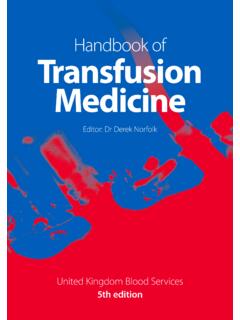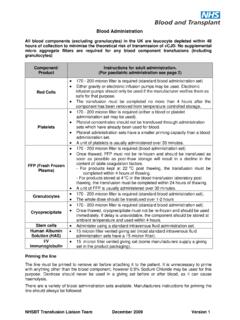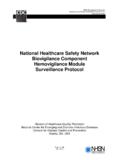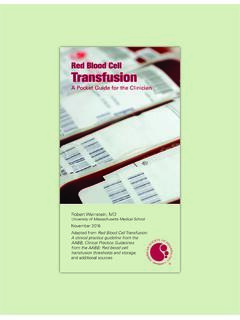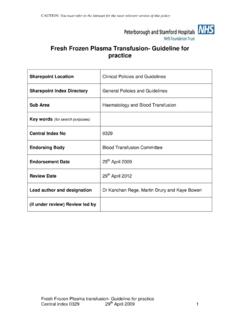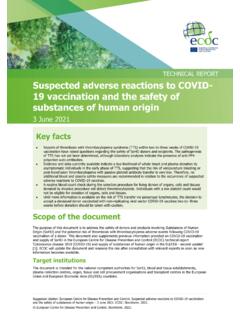Transcription of Blood Transfusion Policy and Procedures
1 Blood Transfusion Policy and Procedures Category: Policy and Procedures Summary: A Blood Transfusion is a potentially hazardous procedure. Stringent Procedures must be followed to ensure that the correct Blood is given and that any adverse reactions are dealt with promptly and efficiently. A Transfusion should only be given when the clinical benefits to the patient outweigh the potential risks. Patients' consent must be sought wherever possible following discussion about potential risks, benefits and possible alternatives. Equality Impact March 2012. Assessment undertaken: Valid From: 21st June 2012. Date of Next Review: June 2015. Approval Date/ Via: 20th June 2012, Clinical Governance Committee Distribution: Divisional Directors and Directorate Managers Blood Transfusion Web Site Related Documents: Statutory and Mandatory Training Policy Patient Identification Policy Incident Reporting and Investigation Policy Injectables Policy Local Guidelines for Blood use in specialities and/or special circumstances Guidelines for the Treatment of Jehovah's Witnesses Guidelines for the Treatment Patients who do not wish to receive Blood or Blood Products (not Jehovah's Witnesses).
2 Author(s): The Blood Safety and Conservation Team Consultant Haematologist in charge of Blood Transfusion , Blood Transfusion Laboratory Manager, Blood Safety and Conservation Team Manager, Transfusion Nurse Specialist. Contact via ext 40395 or 40375. Further Information: OUH Legal Services This Document replaces: Blood Transfusion Policy and Procedures Version Lead Director: Medical Director Issue Date: 21st June 2012. Blood Transfusion Policy Page 1 of 32. Version - June 2012. Oxford University Hospitals Contents Page Introduction 4. Policy Statement .. 4. Scope .. 4. Aim .. 4. Definitions .. 4. Responsibilities 5. Chief Executive 5. Medical Director .. 5.
3 Director of clinical services 5. Blood Safety and Conservation Team .. 5. Hospital Transfusion . 5. Divisional directors .. 6. Matrons . 6. Ward managers 6. Medical staff . 6. Medical and nursing staff .. 6. Phlebotomists .. 7. Porters .. 7. All Staff .. 7. Hospital Transfusion Committee 7. Clinical Risk Management Committee .. 7. Blood Transfusion Procedures 8. 1 - Consent 8. 2 - Identification of the patient 8. 3 - Prescribing Blood 9. 4 Taking Blood samples and requesting pre- Transfusion compatibility testing 9. 5 Requesting Blood .. 10. 6 Preparation of the patient and arranging Blood collection .. 12. 7 Collecting Blood components to be transfused . 13.
4 8 Identifying the patient immediately prior to commencing the Transfusion 14. (bedside check) . 9 How transfusions are .. 16. 10 Special considerations (platelet concentrates, FFP and cryoprecipitate) .. 18. Reporting Incidents . 18. Risk, Audit and Assessment .. 18. Training .. 19. Blood Transfusion Policy Page 2 of 32. Version - June 2012. Oxford University Hospitals Monitoring Compliance 20. Review of this Policy .. 20. References .. 21. Equality Impact Assessment .. 21. Document History .. 21. Appendix 1: The Oxford University Hospitals NHS Trust Blood Transfusion 22. Mandatory Training and Competency Assessment .. Appendix 2: Audit and Assessment Schedule Safe Transfusion Practice and 24.
5 Competency . Appendix 3: An example of indications for special' Blood components (in adult 25. haematology patients) .. Appendix 4: Photograph of a red cell unit, indicating the labels attached by the 26. NHS Blood and Transplant and the Blood Appendix 5: A photograph of the BloodTrack Tx PDA .. 27. Appendix 6: Instructions for the Remote Issue of red cells .. 28. Appendix 7: Procedures for Transfusion during periods of IT failure (down time) 30. Blood Transfusion Policy Page 3 of 32. Version - June 2012. Oxford University Hospitals Introduction 1. A Blood Transfusion is a potentially hazardous procedure which should only be given when the clinical benefits to the patient outweigh the potential risks, the most important of these being acute haemolytic reactions and Transfusion -transmitted infections.
6 Stringent Procedures must be followed to ensure that the correct Blood is given and that any adverse reactions are dealt with promptly and efficiently. 2. This Policy on Blood Transfusion is supported by Procedures on ordering, prescribing, administration of Blood and the management of any complications. Procedures for the documentation of transfusions in nursing, medical and laboratory records are also provided, including the procedure for the reporting of any adverse incidents occurring in relation to Transfusion . Policy Statement 3. It is the Policy of the Trust that Blood transfusions must be conducted according to Procedures annexed to this Policy and must only be conducted by staff who are trained and competent in the Procedures .
7 Scope 4. This Policy applies to all areas of the Trust, and all employees of the Trust, including individuals employed by a third party, by external contractors, as voluntary workers, as students, as locums or as agency staff. Aim 5. The purpose of this Policy is to: ensure that the correct Blood is given and that any adverse reactions are dealt with promptly and efficiently. All staff involved in the process must be appropriately trained and aware of their responsibilities in relation to handling Blood components and performing Transfusion related tasks within their own competence and in accordance with Procedures which are in place to reduce the risks to patients.
8 Definitions 6. See below, link to Glossary of Handbook of Transfusion Medicine for clinical terms used (pp. 73-76): 7. Serious Hazards of Transfusion scheme (SHoT) is the United Kingdom's independent, professionally- led haemovigilance scheme. 8. Medicines and Healthcare products Regulatory Authority (MHRA) is the government agency which is responsible for ensuring that medicines and medical devices work, and are acceptably safe. 9. The term Blood Components refers to units, paedipacks or pooled units of: Red cells Platelets Fresh Frozen Plasma Cryoprecipitate Granulocytes Blood Transfusion Policy Page 4 of 32. Version - June 2012. Oxford University Hospitals 10.
9 Electronic systems: BloodTrack Tx (formerly known as SafeTx') refers to the software in use for prompting best practice and scanning bar codes on wristbands and Blood component labels for the purpose of tracking Blood components, recording Transfusion -related activity and increasing the safety of patient identification throughout the Transfusion process. BloodTrack ward enquiry software which enables clinical staff to view Transfusion -related records, such as sample validity and Blood availability for a patient. Electronic remote issue / remote issue the process whereby a patient who is eligible for electronic issue of red cells (this usually applies to patients who have no special requirements, have a negative antibody screen and a valid sample) is allocated and issued Blood at the point of collection from a specially designed Blood fridge in a clinical area.
10 11. Abbreviations Used: BMS Biomedical Scientist BSACT Blood Safety and Conservation Team CMV Cytomegalovirus EPR Electronic Patient Record MRN Medical Record Number PDA Personal Digital Assistant (refers to the handheld computers in use for scanning bar codes and prompting best practice using the BloodTrack Tx system). Responsibilities 12. The Chief Executive has overall responsibility for ensuring that there is a safe system for Transfusion practice within the organisation. 13. The Medical Director has delegated authority for Transfusion practice within the Trust. 14. The Director of Clinical Services, working with the Trust's Blood Transfusion Committee, is responsible for ensuring that health care professionals and ancillary staff are informed of and follow the Trust Policy .
